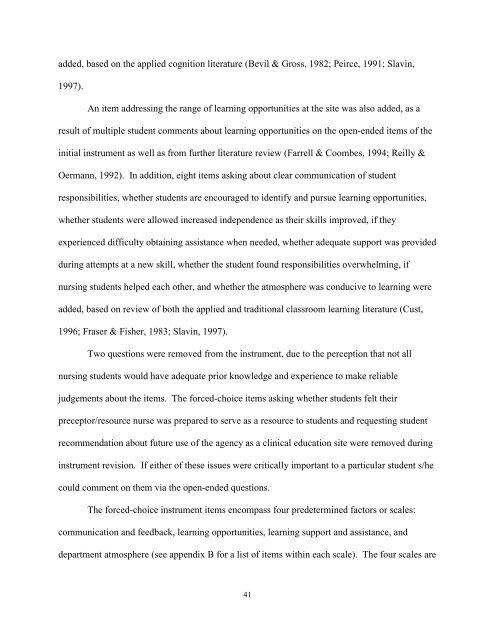STUDENT EVALUATION OF CLINICAL EDUCATION ENVIRONMENT
STUDENT EVALUATION OF CLINICAL EDUCATION ENVIRONMENT
STUDENT EVALUATION OF CLINICAL EDUCATION ENVIRONMENT
You also want an ePaper? Increase the reach of your titles
YUMPU automatically turns print PDFs into web optimized ePapers that Google loves.
added, based on the applied cognition literature (Bevil & Gross, 1982; Peirce, 1991; Slavin,<br />
1997).<br />
An item addressing the range of learning opportunities at the site was also added, as a<br />
result of multiple student comments about learning opportunities on the open-ended items of the<br />
initial instrument as well as from further literature review (Farrell & Coombes, 1994; Reilly &<br />
Oermann, 1992). In addition, eight items asking about clear communication of student<br />
responsibilities, whether students are encouraged to identify and pursue learning opportunities,<br />
whether students were allowed increased independence as their skills improved, if they<br />
experienced difficulty obtaining assistance when needed, whether adequate support was provided<br />
during attempts at a new skill, whether the student found responsibilities overwhelming, if<br />
nursing students helped each other, and whether the atmosphere was conducive to learning were<br />
added, based on review of both the applied and traditional classroom learning literature (Cust,<br />
1996; Fraser & Fisher, 1983; Slavin, 1997).<br />
Two questions were removed from the instrument, due to the perception that not all<br />
nursing students would have adequate prior knowledge and experience to make reliable<br />
judgements about the items. The forced-choice items asking whether students felt their<br />
preceptor/resource nurse was prepared to serve as a resource to students and requesting student<br />
recommendation about future use of the agency as a clinical education site were removed during<br />
instrument revision. If either of these issues were critically important to a particular student s/he<br />
could comment on them via the open-ended questions.<br />
The forced-choice instrument items encompass four predetermined factors or scales:<br />
communication and feedback, learning opportunities, learning support and assistance, and<br />
department atmosphere (see appendix B for a list of items within each scale). The four scales are<br />
41












